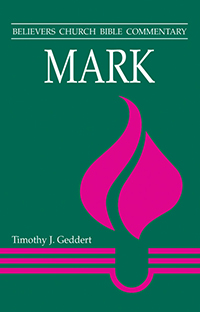The Discipleship Journey (in Mark)
![]() Home A B C D E F G H I J K L M N O P Q R S T U V W X Y Z Abbreviations Glossary
Home A B C D E F G H I J K L M N O P Q R S T U V W X Y Z Abbreviations Glossary
The journey Jesus makes with his disciples to Jerusalem begins and ends with references to the way (hē hodos; 8:27; 10:52). The way symbolizes discipleship. “On the way” the disciples of Jesus misunderstand him, oppose him, argue about greatness, and compete for seats of honor. Though they are literally on the way with Jesus, they are hardly acting as true followers. As the journey ends, a model of faithful discipleship is portrayed in Bartimaeus, who is healed of blindness and follows Jesus on the way (10:52). He symbolizes what the disciples should have been doing all along.
In the previews for 8:27–9:1 and 9:2–10:16, diagrams show how Mark has structured the material from 8:22 through 10:52. The entire journey to Jerusalem is about Christology, discipleship, and the healing of the disciples’ blindness.
At the beginning of the journey, Peter confesses Jesus as the Messiah (8:29). But he immediately shows that he has not fathomed the full meaning of the confession he has made. He opposes Jesus’ teaching about the coming passion. Like the others, he needs the journey to Jerusalem in order to learn to think divine thoughts instead of human thoughts (8:33).
At the end of the journey, Bartimaeus confesses Jesus as the Messiah (10:47-48). Peter’s confession is perhaps more technically complete, but he incorrectly understands it. Bartimaeus’ confession may be more vague and incomplete, but he understands correctly and acts upon it.
Confessing Jesus as the Christ must flow into a life of faithful discipleship. Otherwise, the confession counts for nothing. For Mark, both a correct Christology and faithful discipleship are inseparably tied to a third theme: discernment, “hearing ears and seeing eyes” (4:12). Because the kingdom comes secretly (4:11), because the Messiah comes incognito (4:41), only those whose eyes are truly opened in the context of faithful discipleship will be ready to join Jesus on the road to glory by way of the cross.
At the beginning of the journey, the healing of the blind man from Bethsaida (8:22-26) symbolizes what has been happening and still needs to happen to the disciples of Jesus. They are still partly blind, seeing people as trees walking (8:24). They need another touch before they will be able to see everything clearly (8:25).
At the end of the journey, Bartimaeus is healed of blindness. His full healing is clearly indicated by his willingness to follow Jesus on the road of discipleship. The healing of Bartimaeus does not symbolize what has happened to the disciples on this journey. It symbolizes rather what is possible for disciples—what must yet happen.
Discipleship involves more than mouthing correct confessions; it is a journey of faithful following. It involves giving up everything to join Jesus; it involves true following, not merely physical journeying. It involves perseverance on the road to the cross.
Teaching true discipleship was Jesus’ goal on the journey to Jerusalem and it is Mark’s goal in narrating that journey for his readers. Bartimaeus is a “good example.” The disciples are sometimes portrayed as “bad examples” (TBC for 10:17-52). But Mark’s goal is that both types of example become motivators for us as we keep our eyes fixed on the ideal, as we renew courage and hope when we fall short. In reality, all disciples are “fallible followers” (Malbon, 1983: 47–48), always needing to be challenged, to be forgiven, and to be allowed new beginnings.
Bibliography
- Best, Ernest. Mark: The Gospel as Story. Edinburgh: T & T Clark, 1983.
- Dewey, Joanna. Disciples of the Way: Mark on Discipleship. Cincinnati: Women’s Division, Board of Global Ministries, United Methodist Church, 1976.
- Kingsbury, Jack Dean. Conflict in Mark: Jesus, Authorities, Disciples. Minneapolis: Fortress, 1989.
- Meye, Robert P. Jesus and the Twelve: Discipleship and Revelation in Mark’s Gospel. Grand Rapids: Eerdmans, 1968.
- Myers, Ched. Binding the Strong Man: A Political Reading of Mark’s Story of Jesus. Maryknoll, N.Y.: Orbis, 1988.
- _____. “Say to This Mountain”: Mark’s Story of Discipleship. Maryknoll, N.Y.: Orbis, 1996.
- Schweizer, Eduard. Lordship and Discipleship. Naperville, Ill.: Allenson, 1960.
- Swartley, Willard M. Mark: The Way for all Nations. Scottdale, PA: Herald, 1981. Reprint, Eugene, OR: Wipf & Stock, 1999.
| —Timothy J. Geddert |
